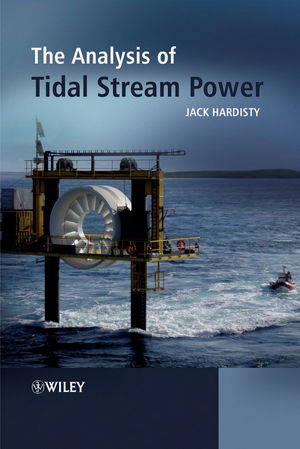The Analysis of Tidal Stream PowerISBN: 978-0-470-72451-4
Hardcover
342 pages
June 2009
 This is a Print-on-Demand title. It will be printed specifically to fill your order. Please allow an additional 10-15 days delivery time. The book is not returnable.
|
||||||
Website contents.
Origin of online images.
Copyright acknowledgements.
Symbols.
Part I Theory.
1 History of tidal and turbine science.
1.1 Introduction.
Part 1 Tidal science.
1.2 Antiquity: Aristotle and Ptolemy.
1.3 Middle Ages: Copernicus to Galileo.
1.4 Isaac Newton and the equilibrium theory.
1.5 Measurement after Moray.
1.6 Eighteenth and nineteenth centuries: Laplace to Kelvin.
1.7 Tide-predicting machines.
1.8 Tidal currents.
Part 2 Turbine science.
1.9 Antiquity: the Romans and Chinese.
1.10 Middle Ages: the Syrians and Agricola.
1.11 Eighteenth and nineteenth centuries: Smeaton to Kaplan.
1.12 Modern turbines.
1.13 Summary.
1.14 Bibliography.
2 Tidal hydraulics.
2.1 Introduction.
2.2 Elementary fluid flow.
2.3 Hydraulic power.
2.4 Turbulence and the Reynolds number.
2.5 Critical flow and the Froude number.
2.6 Bernoulli’s equation.
2.7 von Kármán’s equation.
2.8 Properties of the Airy wave.
2.9 Tides in estuaries.
2.10 Harmonic prediction of tidal currents.
2.11 Turbulent characteristics of tidal currents.
2.12 Redundancy and intermittency.
2.13 Summary.
2.14 Bibliography.
3 Principles of tidal power devices.
3.1 Introduction.
3.2 Tidal wheels, mills, and barrages.
3.3 Efficiency, capacity factor, and solidity ratio.
3.4 Hydraulic processes, Part I: Tidal stream power.
3.5 Hydraulic processes, Part II: Ducts and diffusers.
3.6 Turbine processes, Part I: Drag and lift forces.
3.7 Turbine processes, Part II: Shaft power.
3.8 Electrical processes, Part I: Overview and generators.
3.9 Electrical processes, Part II: Cabling and grid connection.
3.10 Categories of turbines.
3.11 Horizontal-axis devices.
3.12 Vertical-axis devices (crossflow turbines).
3.13 Summary.
3.14 Bibliography.
4 Tidal power technologies.
4.1 Introduction.
4.2 Blue Energy.
4.3 Clean Current.
4.4 Engineering Business.
4.5 Gorlov helical turbine.
4.6 Hammerfest Strøm.
4.7 Lunar Energy.
4.8 Marine Current Turbines.
4.9 Neptune Renewable Energy.
4.10 OpenHydro.
4.11 Ponte di Archimede (Kobold).
4.12 Pulse Generation.
4.13 SeaPower.
4.14 SMD Hydrovision.
4.15 Underwater electric kite.
4.16 Verdant Power.
4.17 Other proposals.
4.18 Early-stage proposals.
4.19 Bibliography.
5 Modelling tidal stream power.
5.1 Introduction.
5.2 Global tidal streams.
5.3 Tidal datum and tidal heights.
5.4 British Admiralty tidal diamonds.
5.5 Harmonic decomposition.
5.6 STEM display screen.
5.7 Running STEM.
5.8 Case study at Flat Holm in the Bristol Channel.
5.9 Case study at Hull St Andrews in the Humber Estuary.
5.10 Summary.
5.11 Bibliography.
Part II Practice.
6 Economics and finance.
6.1 Introduction.
6.2 The Renewable Energy Business.
6.3 Costs.
6.4 Revenue.
6.5 Economic result.
6.6 Conclusions.
6.7 Bibliography.
7 North-west Europe.
7.1 Introduction.
7.2 Geography of north-west Europe.
7.3 Oceanography of north-west Europe.
7.4 Mediterranean.
7.5 Spain and Portugal.
7.6 France.
7.7 Belgium, the Netherlands, and Germany.
7.8 Denmark and Norway.
7.9 United Kingdom.
7.10 The estuaries.
7.11 Bibliography.
7.12 Appendix: STEM outputs for north-west Europe.
8 North America.
8.1 Introduction.
8.2 Geography of North America.
8.3 Oceanography of North America.
8.4 East coast of Canada.
8.5 East coast of the United States.
8.6 West coast of Canada.
8.7 West coast of the United States.
8.8 Bibliography.
8.9 Appendix.
9 Australia and New Zealand.
9.1 Introduction.
9.2 Timor Sea.
9.3 Arafura Sea.
9.4 Coral Sea.
9.5 Bass Strait.
9.6 New Zealand.
9.7 Bibliography.
9.8 Appendix: STEM outputs for Australia and New Zealand.
10 Rest of the world.
10.1 Introduction.
10.2 Barents Sea.
10.3 Western South Atlantic.
10.4 Western Indian Ocean.
10.5 East Arabian Sea.
10.6 Indonesia and the Java Sea.
10.7 East China and Yellow Seas.
10.8 Bibliography.
10.9 Appendix.
Glossary.
Index.



